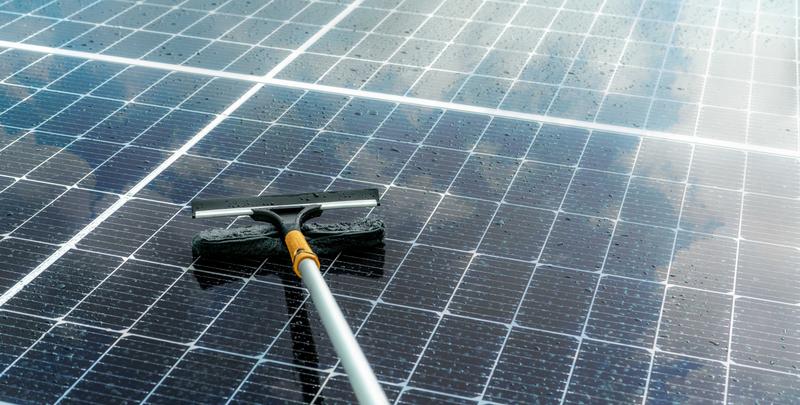
If you’re attempting to find a substantial-functionality
Why Photo voltaic Panel Cleaning Matters
Photo voltaic panels capture Power at their most effective when cleanse. Dust, pollen, fowl droppings, and smog reduce efficiency—sometimes by 20% or even more. Normal cleaning assists maintain exceptional general performance, prolong panel lifestyle, and protect your financial investment.
Key Positive aspects:
- Improved Electricity output
- Reduced electricity payments
- Prolonged panel lifespan
- Lowered possibility of micro‑cracks on account of thermal hotspots
Kinds of Photo voltaic Cleansing Tools
Picking out the correct Resource depends upon your set up, drinking water availability, and wished-for ease. Groups consist of:
- Drinking water‑run photo voltaic brush systems
- Transportable solar panel cleaning package bundles
- Pure h2o cleansing techniques
- Rotary photo voltaic brushes and extension poles
H2o Run Solar Brush Techniques
These brushes connect with a drinking water resource and spin whilst dispensing drinking water, combining cleaning and lubrication in one action. The end result: spotless panels with out scratching.
Crucial Options:
- Built-in h2o feed through the brush head
- Gentle bristles Risk-free for glass surfaces
- Rotary movement lessens handbook effort and hard work
- Mounts on extension poles for rooftop access
Portable Solar Panel Cleansing Package
An entire
- Brush head (preset or rotating)
- Extension pole (adjustable lengths up to six m)
- Hose adapters or brief‑join fittings
- Pure‑h2o tank or filtration process
- Gentle microfiber towels or squeegees
- Non‑abrasive cleaning Alternative (if authorized)
Advantages of All-in-One particular Kits:
- Start off cleaning with minimal set up
- Compact for storage or journey
- Compatible with residential or professional solar arrays
Pure Water Photo voltaic Cleaning Methods
These systems purify local h2o—eliminating minerals and Filth—so it won’t go away scale or streaks. Pure drinking water empowers Experienced-quality final results without the need of chemicals.
How It really works:
- Pretreatment filtration (sediment, carbon, ion Trade)
- Closing deionization or reverse‑osmosis stage
- Filtered h2o circulated via brush for cleansing
- Residue‑cost-free drying—no spots or streaks still left powering
Rotary Photo voltaic Brush & Extension Poles
For large solar arrays or business use, a power-rotating head on the telescoping extension pole would make cleaning efficient and Risk-free.
Benefits:
- A lot less physical effort and hard work, more rapidly protection
- Attain roofs and floor‑mounted panels simply
- Adjustable shaft lengths for varying angles
- Universal speedy‑connect tricks for accessories
Target Protection & Best Tactics
Cleansing solar panels includes heights and slippery surfaces—protection first:
- Use non‑conductive extension poles
- Keep away from force washers that can crack glass
- Perform early or late to stop glare and warmth
- Put on grips and slip-resistant footwear
- Notice area water‑use guidelines or limits
Step‑by‑Action Cleaning Program
- Flip from the photo voltaic inverter or ensure process is deactivated
- Rinse panels with minimal‑pressure drinking water
- Make use of a brush (or photo voltaic brush package) with drinking water feed
- Scrub Carefully in overlapping, linear passes
- Rinse carefully with clean water
- Dry with microfiber squeegee or gentle towel—provided that required
Deciding on the Correct Solar Panel Cleaning Software
Consider your set up along with your water obtain:
Upkeep & Care Ideas
- Flush hose and brush right after Each individual use
- Retailer dry, clean up, and far from UV exposure
- Swap worn brush heads—and check bristle softness
- Inspect seals and connectors for leaks
- Substitute or clean filters in pure‑water techniques routinely
Eco-Pleasant Cleaning Rewards
Proper cleaning prolongs solar panel effectiveness and decreases Strength waste. Making use of water by itself—devoid of soaps or chemical substances—assists maintain local ecology and avoids runoff pollution.
How Solar Panel Cleansing Impacts ROI
Smart maintenance making use of good quality brushes and kits keeps technique effectiveness topped up, cutting down the payback period of time and maximizing Electricity generate eventually.
Price tag Criteria & Benefit
- H2o‑driven solar brushes are Expense-successful and sturdy
- Pure drinking water techniques demand upfront expenditure but supply steady, spot‑free cleansing
- Rotary brush kits Raise productiveness—worthwhile for giant installations
- Do-it-yourself kits conserve labor costs; Experienced expert services Value a lot more but free up your time and energy
Widespread Makes use of of Photo voltaic Panel Brushes
- Residential rooftops
- Professional solar farms
- RV or cell installations
- Solar carports
- BIPV segments (making‑integrated photovoltaics)
Shopper Recommendations & Use Situations
“This solar panel cleaning brush made a visible distinction in just minutes—dust gone, no streaks, and our output enhanced!”
“Upgrading to a drinking water‑run solar brush saved hrs of scrubbing. Coupled with a pure water technique, the panels appeared completely new.”
FAQs About Photo voltaic Panel Cleansing
How often need to panels be cleaned?
Every 6 to twelve months, depending on your local weather—additional frequently in dusty or pollen-weighty locations.
Can rain clear photo voltaic panels?
Rain helps but doesn’t eradicate Filth buildup or movie levels—handbook cleansing yields much better functionality.
Am i able to use faucet drinking water?
Faucet drinking water may well go away mineral residue. A
Can cleansing problems panels?
Provided that abrasive instruments or superior-tension washers are used. Usually use gentle bristles, lower-tension, and follow manufacturer tips.
Professional Guidelines for Photo voltaic Panel Owners
- Clear early morning or evening in order to avoid thermal worry
- Keep track of output information—if general performance drops, thoroughly clean panels
- Preserve panels angled—standing water promotes algae development if left also extended
- Rotate brush heads periodically to keep up even dress in
Conclusion: A Brush for Every Want
No matter if you’re on the lookout for a value-efficient
Take a look at the full line of brushes and add-ons created specifically solar brush for solar cleaning at